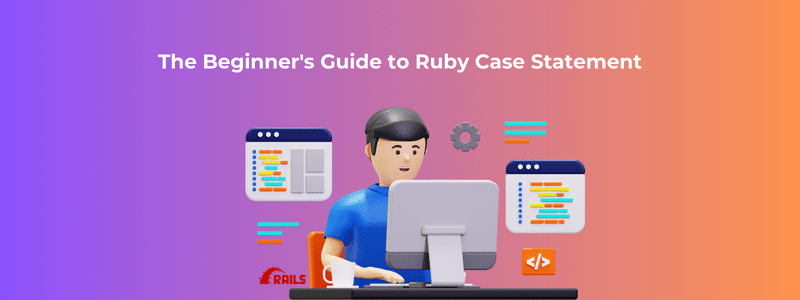In the ever-evolving landscape of web development, certain technologies stand the test of time, proving their resilience and adaptability. One such stalwart in the realm of web frameworks is Ruby on Rails (RoR). As we step into 2024, it’s worth exploring why Ruby on Rails remains a steadfast choice for developers and businesses alike.
Understanding Ruby on Rails: A Brief Overview
Ruby on Rails, commonly known as Rails or RoR, is an open-source web application framework written in the Ruby programming language. Created by David Heinemeier Hansson and released in 2005, Rails has since gained popularity for its focus on simplicity, convention over configuration, and the principles of don’t repeat yourself (DRY) and convention over configuration (CoC).
- Ease of Development:
One of the enduring strengths of Ruby on Rails is its emphasis on developer happiness and productivity. The framework follows the principle of convention over configuration, meaning developers can focus more on writing application code rather than configuring files. This results in a streamlined development process and shorter time-to-market for projects.
- Rapid Prototyping:
In the fast-paced world of web development, the ability to quickly prototype and iterate on ideas is invaluable. Ruby on Rails excels in this area, allowing developers to rapidly build and test prototypes. This feature is particularly beneficial for startups and projects with evolving requirements.
- Community and Ecosystem:
Ruby on Rails boasts a vibrant and supportive community. This community-driven approach ensures a wealth of resources, gems (Ruby libraries), and plugins readily available for developers. The collaborative spirit of the Ruby on Rails community fosters knowledge sharing and continuous improvement.
- Scalability:
Contrary to the misconception that Ruby on Rails is not scalable, the framework has proven its scalability in numerous high-traffic applications. With proper architecture and optimization, Rails applications can handle significant loads. Several successful startups and established companies continue to rely on Ruby on Rails for their scalable web solutions.
- Maintainability and Readability:
The elegant and readable syntax of the Ruby language contributes to the maintainability of Rails applications. Code readability is a core principle in Ruby on Rails, making it easier for developers to understand and work on existing codebases. This attribute is essential for long-term project sustainability.
- Active Record ORM:
Ruby on Rails incorporates the Active Record ORM (Object-Relational Mapping) pattern, simplifying database interactions. This abstraction layer allows developers to interact with databases using Ruby code, reducing the need for complex SQL queries. The result is cleaner, more maintainable database code.
- Security Standards:
Security is a paramount concern in web development, and Ruby on Rails is committed to maintaining high-security standards. The framework provides built-in security features and follows best practices, helping developers create secure applications. Regular updates and a vigilant community contribute to a robust security posture.
- Versatility and Flexibility:
Ruby on Rails is versatile and suitable for a wide range of applications. Whether you’re building a content management system (CMS), e-commerce platform, or social networking site, Rails provides the flexibility to meet diverse project requirements. Its modular architecture supports the integration of third-party libraries and tools.
- Developer Satisfaction:
The developer experience is a key factor in the longevity of any technology. Ruby on Rails has consistently prioritized developer satisfaction by offering an enjoyable and efficient development environment. This focus on the well-being of developers contributes to the framework’s enduring popularity.
- Adaptation to Modern Trends:
Despite being more than a decade old, Ruby on Rails continues to adapt to modern web development trends. Regular updates and releases introduce features and improvements aligned with the evolving needs of the industry. The framework remains relevant in an era of microservices, APIs, and serverless architectures
How It Is Beneficial For Development Of Web Application
Ruby on Rails (Rails) offers several benefits for the development of web applications, making it a popular choice among developers. Here are key advantages of using Ruby on Rails for web application development:
Rapid Development:
Rails follows the convention over configuration (CoC) and don’t repeat yourself (DRY) principles, streamlining the development process. This results in faster development cycles, allowing developers to build and iterate on applications more quickly.
Convention-Based Configuration:
Rails enforces a set of conventions, reducing the need for developers to write extensive configuration code. This makes the development process more straightforward and minimizes the boilerplate code traditionally associated with web development.
Developer Productivity:
Ruby on Rails emphasizes developer happiness, offering a clean and readable syntax. This focus on productivity contributes to a positive development experience, reducing friction and making it enjoyable for developers to work on projects.
Active Record ORM:
Rails incorporates the Active Record ORM, simplifying database interactions. Developers can use Ruby code to interact with databases, avoiding the need for complex SQL queries. This abstraction layer enhances code readability and maintainability.
Scalability:
Contrary to some misconceptions, Rails applications can be scalable when properly designed and optimized. With the right architecture and best practices, Rails supports the development of scalable web applications that can handle increased traffic and user load.
Extensive Gem Ecosystem:
Rails leverages the RubyGems package manager, allowing developers to easily integrate third-party libraries and extensions (gems) into their applications. The extensive gem ecosystem provides solutions for various functionalities, saving development time and effort.
Community Support:
Ruby on Rails has a vibrant and supportive community. The community actively contributes to the framework, shares knowledge through forums and conferences, and maintains a wealth of documentation and tutorials. This support system is valuable for developers seeking assistance and staying updated on best practices.
Security Features:
Rails incorporates built-in security features, including protection against common web vulnerabilities such as cross-site scripting (XSS) and cross-site request forgery (CSRF). This helps developers build more secure applications by default.
RESTful Architecture:
Rails encourages the use of RESTful principles for defining application endpoints. This approach simplifies API design and promotes a standardized way of handling HTTP methods, improving the clarity and consistency of the application’s interface.
Maintainability:
The convention-based approach of Rails and the DRY principle contribute to code maintainability. Developers can easily understand and navigate codebases, making it simpler to update and extend applications over time.
Versatility:
Ruby on Rails is versatile and suitable for various types of applications, from content management systems (CMS) and e-commerce platforms to social networking sites. Its modular architecture supports the integration of third-party tools and libraries.
Community-Driven Innovation:
The Rails community actively contributes to the continuous improvement of the framework. Regular updates and releases introduce new features and improvements aligned with the evolving needs of the industry, ensuring that Rails remains relevant.
What are the challenges?
While Ruby on Rails (Rails) is a powerful and popular web application framework, like any technology, it comes with its set of challenges. Understanding these challenges is crucial for developers and businesses to make informed decisions. Here are some common challenges associated with Desarrollo de Ruby on Rails:
Learning Curve:
For developers unfamiliar with Ruby on Rails or the Ruby programming language, there can be a learning curve. While Rails emphasizes convention over configuration, mastering the conventions and best practices may take some time.
Performance Concerns:
Historically, Ruby on Rails has faced criticism for its performance compared to some other web frameworks. While there have been performance improvements in recent versions, developers may need to optimize code and employ caching strategies for high-traffic applications.
Scalability Misconceptions:
There is a common misconception that Ruby on Rails is not suitable for scalable applications. While Rails applications can be scalable with proper design and optimization, this misconception persists. Developers need to implement best practices and consider scalability concerns from the early stages of development.
Upgrading Versions:
Upgrading to newer versions of Ruby on Rails can be challenging, especially for large and complex applications. The process may involve updating dependencies, addressing deprecated features, and ensuring compatibility, which requires careful planning and testing.
Monolithic Architecture:
While the monolithic architecture of Ruby on Rails is beneficial for many applications, it may not be the best fit for microservices-based architectures. Breaking down large applications into microservices may pose challenges, and alternative frameworks may be preferred in such cases.
Conventions Limit Flexibility:
While conventions in Rails contribute to productivity, they may limit flexibility for developers who prefer more control over configuration. Some developers may find it challenging to deviate from Rails’ conventions in certain situations.
Resource Intensive:
Ruby on Rails applications can be resource-intensive, especially in terms of memory usage. Developers need to optimize code, use efficient database queries, and consider caching strategies to ensure optimal performance.
Community Dynamics:
While the Ruby on Rails community is vibrant, the framework has experienced a shift in popularity in recent years with the rise of alternative technologies. Developers may find a more diverse set of opinions on best practices, and some gems or libraries may not be as actively maintained.
Maintaining Older Codebases:
For projects built on older versions of Ruby on Rails, maintaining and updating the codebase can be challenging. Dependencies may become outdated, and the process of bringing the codebase up to date may require careful consideration and testing.
Front-End Development Integration:
Rails primarily focuses on server-side development, and integrating modern front-end frameworks may require additional configuration. For developers who prefer using specific front-end technologies, this integration may pose challenges.
Vendor Lock-In Concerns:
Some developers express concerns about potential vendor lock-in when using Ruby on Rails. While it is an open-source framework, the choice of language and framework can impact long-term flexibility and portability.
Preguntas frecuentes
Ruby on Rails continues to be a robust and developer-friendly framework with a proven track record. Its convention-over-configuration approach, emphasis on developer happiness, and the vibrant community make it a solid choice for building web applications. While newer frameworks exist, Rails offers stability, productivity, and adaptability to modern development trends.
Yes, Ruby on Rails remains relevant for scalable applications when implemented with best practices. While performance considerations exist, Rails has evolved with each version, addressing performance concerns. Many successful startups and established companies still trust Ruby on Rails for building scalable web solutions with the right architecture and optimization.
Some challenges include a learning curve for developers new to Rails, potential performance optimization requirements, and misconceptions about scalability. It's essential to consider application requirements, plan for upgrades, and stay informed about best practices to address these challenges effectively.
While Ruby on Rails traditionally follows a monolithic architecture, it can adapt to modern trends. Developers have successfully implemented microservices using Rails, although breaking down large applications may pose challenges. While not inherently designed for serverless architectures, Rails applications can be deployed on serverless platforms with proper configuration.
The Ruby on Rails community plays a pivotal role in the framework's ongoing relevance. The community actively contributes to updates, shares knowledge, and provides support through forums and conferences. The collaborative spirit ensures that Rails remains adaptable to industry changes and continues to meet the evolving needs of developers and businesses.





